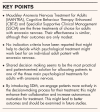Developments in the psychological treatment of anorexia nervosa and their implications for daily practice
- PMID: 32796187
- PMCID: PMC7575018
- DOI: 10.1097/YCO.0000000000000642
Developments in the psychological treatment of anorexia nervosa and their implications for daily practice
Abstract
Purpose of review: Our aim is to give an overview of the recent literature on psychological treatment for young adults and adults with anorexia nervosa and to discuss the implications of the findings for clinical practice.
Recent findings: Three systematic reviews and meta-analyses have recently been published on psychological treatments for anorexia nervosa. Treatment outcomes are still modest and mainly focus on weight outcome, although outcomes for eating disorder disease and quality of life have also been reported. Adhering to a treatment protocol might lead to faster and better results.
Summary: For children and adolescents with anorexia nervosa, the major guidelines recommend a family-based treatment. The treatments of choice for young adults and adults with anorexia nervosa are the Maudsley Anorexia Nervosa Treatment for Adults (MANTRA), Cognitive Behaviour Therapy-Enhanced (CBT-E) and Specialist Supportive Clinical Management (SSCM), but none of these treatments seem to be superior. In search of other ways to improve outcome, shared decision making may be a way to help patients become more involved in their treatment, enhance their motivation and consequently improve the outcome.
Conflict of interest statement
There are no conflicts of interest.
References
-
- Smink FR, van Hoeken D, Hoek HW. Epidemiology, course, and outcome of eating disorders. Curr Opin Psychiatry 2013; 26:543–548. - PubMed
-
- Keski-Rahkonen A, Mustelin L. Epidemiology of eating disorders in Europe: prevalence, incidence, comorbidity, course, consequences, and risk factors. Curr Opin Psychiatry 2016; 29:340–345. - PubMed
-
- Galmiche M, Dechelotte P, Lambert G, Tavolacci MP. Prevalence of eating disorders over the 2000–2018 period: a systematic review. Am J Clin Nutr 2019; 109:1402–1413. - PubMed
-
- Wonderlich SA, Bulik CM, Schmidt U, et al. Severe and enduring anorexia nervosa: update and observations about the current clinical reality. Int J Eat Disord 2020. 1–10. [Epub ahead of print]. - PubMed
-
This review article provides an overview of recent diagnostic issues and evidence-informed clinical strategies for treating severe and enduring anorexia nervosa.
-
- Brockmeyer T, Friederich HC, Schmidt U. Advances in the treatment of anorexia nervosa: a review of established and emerging interventions. Psychol Med 2018; 48:1228–1256. - PubMed
Publication types
MeSH terms
LinkOut - more resources
Full Text Sources
Research Materials


